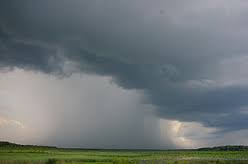Research highlights (June 2015)

by Simon Walker (OzEWEX)

The Millennium Drought caused a shift in catchment rainfall-runoff relationships, soil carbon in Queensland’s cloud forests is sensitive to warming, hail stones are bigger in Sydney, using wavelet transforms to analyse climate trends, and experiencing wildfire does not change views on climate change.
Millennium Drought caused a shift in catchment rainfall-runoff relationships
Margarita Saft of the University of Melbourne and her colleagues explored changes in how annual rainfall is converted into annual runoff during long dry periods (e.g., a decade). “We found that approximately half of the catchments experienced significantly higher runoff reductions than expected from other dry periods in the record. This confirms catchment behaviour can shift during sustained precipitation change from what has been witnessed in the past.” According to Saft, the results place limitations on the applicability of projection methods utilising historical streamflow records, such as the elasticity concept, while also offering new insights into catchment response time scales. Changing rainfall-runoff relationships during long dry periods has implications for water resources risk management and hydrological projections of climate change.
Saft et al. (2015) The influence of multiyear drought on the annual rainfall-runoff relationship: An Australian perspective, Water Resources Research (link)
Soil carbon in Queensland’s cloud forests sensitive to warming
Tropical forests store large amounts of carbon in biomass and soils, and moisture and temperature are known to be the key drivers of natural carbon fluxes. Soil carbon input and output fluxes are balanced under natural conditions, however, small changes in environmental conditions might lead to changed carbon storage potentials in tropical ecosystems. to investigate this, Michael Zimmerman of James Cook University and his team conducted a translocation experiment along Mt Bellenden Ker in North Tropical Queensland. “We found that soil carbon reacted very vulnerable to warming whereas soils at higher elevations with higher soil carbon stocks were more sensitive to warming than soils at lower altitudes”.
Zimmermann et al. (2015) Impact of temperature and moisture on heterotrophic soil respiration along a moist tropical forest gradient in Australia. Soil Research (link)
Hail stones are bigger in Sydney
In a recent study examining hail storm frequency and spatial distribution in NSW since the 1950s, Ali Rasuly of Macquarie University and his colleagues found that the largest hail stones of magnitude 6.2-12 cm were all in the vicinity of metropolitan areas. According to co-author Kevin Cheung, “This is alarming us to future economic losses due to these storms. Thunderstorms are sources of fresh water but at the same time threats to human lives and infrastructures, this climatology of storm events has enormous implications to the hydrological environment of New South Wales.”
Rasuly et al. (2015) Hail events across the Greater Metropolitan Severe Thunderstorm Warning Area. Natural Hazards and Earth System Sciences (link)
Using wavelet transforms to analyse climate trends
Mohammed Rashid of the University of South Australia and colleagues used annual, seasonal and monthly rainfall at thirteen stations in South Australia to develop a new trend analysis technique. The technique involves combining a Continuous Wavelet Transform with the Mann Kendall test. “We showed that general low frequency components have significant trends even though the original data did not have any significant trends.” According to the authors, their analysis technique may prove useful for more accurate estimation of water resource system reliability.
Rashid et al. (2015) Assessment of trends in point rainfall using Continuous Wavelet Transforms. Advances in Water Resources (link)
Experiencing wildfire does not change views on climate change
Peoples’ experiences of recent consecutive wildfire events do not necessarily influence their views on climate change. This is the conclusion that Joanne Millar of Charles Sturt University and colleagues drew after interviewing 40 people around Beechworth, Victoria. “People tend to focus on more visible and tangible factors that might lead to a wildfire event, such as forest management.” Rather than try to change climate change perceptions, disaster managers and policy makers should support people to prepare, respond and recover from wildfires, according to Millar. She notes that further research would be needed to better understand the relationship between wildfire experiences, climate change views and adaptive behaviours across a wide range of social contexts.
Millar et al. (2015) Do wildfire experiences influence views on climate Change? International Journal of Climate Change Strategies and Management (link)
